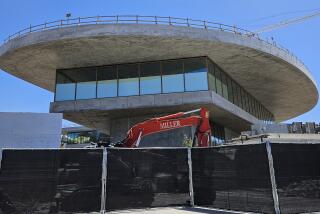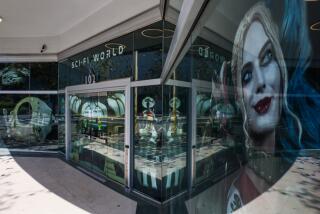Museum Shows Lore of Missile Silo
- Share via
TUCSON — Interstate 19 cuts through the Arizona desert south of here, past giant saguaro cactuses, purple mountains, the 18th-Century mission of San Xavier del Bac, and hills of copper tailings from a mine. The landscape is rugged, barren and beautiful.
But just before reaching the retirement community of Green Valley, 25 miles outside of Tucson, this peaceful desert hosts another stark monument--a nuclear missile silo that has been opened as a museum. Called the Titan Missile Museum, it’s the only one of its kind in the world.
The Titan II silo was removed from active alert in November, 1982. In May, 1986, it was made into a museum. More than 40,000 tourists from as far away as China, Australia, Iran, South Korea and Greenland have visited the site, which is kept in working order down to the alert siren and the emergency phones.
Only the nuclear warhead has been dismantled. In keeping with the SALT II agreement, it was placed on view next to the silo for 30 days to allow Russian satellites to photograph it. Today, its shell is still there for tourists to see.
The silo is less than one-fourth of a mile from the highway, but signs pointing the way are the only clues to its existence. Most of the 110-foot missile is underground. Until the museum opened, many Green Valley residents had no idea it was here.
Wind-Swept Site
The lonely, wind-swept site fits the image many people have of how the earth might look if Titan II missiles had ever been fired. On a hill behind the silo, copper trains rumble by on the way to the Duval mine and above the steps leading into the 146-foot, eight-story silo is a sign saying, “Watch for Rattlesnakes.”
Tour guides have never encountered a rattler, but not long ago a Gila monster stood defiantly on the steps of the entrance, blocking the tourists. It turned out that the Gila monster was just curious and was carefully scooped up and carted away.
Each tour takes about an hour and most are led by retirees who volunteer their time.
Everyone is required to wear hard hats to protect against head injuries from low ceilings and sharp corners. The hats are also on sale in the gift shop, along with baseball caps, key chains, scale models, post cards, books, spoons and tie tacks--all of which bear the Titan insignia.
The first stop on the tour is 35 feet below the surface. Visitors walk down stairs and step through three-ton doors into the command center, also called a “shock isolation cage.” It is an egg-shaped, three-story room suspended on huge springs. Designers hoped the suspension would allow the room to absorb a first strike and the missile crew would still be able to retaliate.
The room is like something out of a B movie. It has an elaborate control panel covered by blinking lights and switches and a red safe containing command-code books.
A guide plays a tape of how it would sound to the four-man crew if the order came to fire. A frantic voice says: “Red dash alpha message in two parts.” The tape goes on as the guide demonstrates the 13 steps necessary to launch the missile.
‘No-Lone’ Zone
The command center is a “no-lone” zone, meaning that no member of the crew was allowed in there alone. If instructed to fire, the two officers, each using his own combination, would open the safe and consult the codes to decipher the order. At the final step, each officer would simultaneously turn keys on the control panel, which are far enough apart so that two people would be needed to complete the launch.
At the end of a long metal platform flanked by cables is the launch duct, a circular, tunnel-like structure containing the missile.
Visitors look through windows on the side of the duct as guides explain what would happen at liftoff.
As part of a sound attenuation system, 100,000 gallons of water would be pumped into the duct--at 9,000 gallons a minute--to keep the 150-ton missile from being destroyed by vibration. The water explains the steam that rises from the ground at launch.
The Titan II was deployed in 1963. It had a range of 5,000 miles and was the largest intercontinental ballistic missile the United States built. Eighteen Titan II silos were constructed in the Tucson area, and, with the exception of the museum, they all have been destroyed.
A few Titan IIs are still on active alert in Arkansas, but they will be dismantled by October as part of the government’s strategic modernization program.
The privately owned Pima Air Museum, which leases the silo from the government, had to get approval from the Pentagon before opening the museum. Among the conditions that had to be met was proving to the Soviets that the site was no longer active.
This involved building a concrete barrier behind the silo doors to keep them from opening all the way, putting a cover over the open half and cutting windows in the silo.
“It gave the Russians some say over what we could do,” says Charles Niblett, a retired Air Force officer instrumental in getting the museum started. “But we don’t think it hurt us.”
One Objection
So far Niblett is aware of only one objection to the museum. It came when a Phoenix newspaper reporter quoted a spokesman for an anti-nuclear group, who said the museum “glorified mega-death.”
Niblett says the site is nothing more than a report to the nation on how Americans were protected. “I don’t feel this museum is any different from Old Ironsides in Boston Harbor,” he says.
In some ways the site is still rather primitive. The only bathrooms on the grounds are portable toilets, and all the water is trucked in. Manager Becky Roberts said plans are under way to upgrade the facilities, including the installation of permanent restrooms.
Visitors, many of whom are winter residents of Tucson and retired Air Force people, don’t seem to mind the museum. As a tour group returned to the surface, one elderly woman beamed with pride. “It makes me feel good to know we are protected,” she said. “That’s quite a missile.”
Another woman shook her head and mumbled, “I like seeing where all my money went, but I don’t understand that technical stuff. The guys probably do.”
Adolph Schumann of Eyota, Minn., who flew B-25s for the Air Force during World War II, was shocked to learn how much of the complex was underground, concealed from view.
‘We Hid It Pretty Good’
“I’m visiting friends in Green Valley and I suggested we tour the missile silo,” Schuman said. “They asked, ‘What missile silo?’ I guess we hid it pretty good, huh?”
The most common reaction is amazement at the complexity of the project.
“I don’t know how to describe it,” says Eleanor Moser of Chanute, Kan. “Overwhelming is a good word, I suppose. My little mind just can’t comprehend what it must have taken to build one of these. It’s absolutely marvelous.”
Moser started to walk away and turned back. “And if it ever went off?” she says, rolling her eyes.
“I was aware these things were set up in the ‘60s,” says Jean Hoel of Park Forest, Ill., “but to actually go down inside one is remarkable.”
Admission to the Titan Missile Museum is $4 for adults, $3 for seniors and active military personnel, and $2 for children ages 10 through 17. Children aged 9 and under are admitted free.
The museum is open seven days a week beginning with a tour at 9 a.m. Tours continue on the hour throughout the day. The last tour begins at 4 p.m. Reservations are requested.
More to Read
Sign up for The Wild
We’ll help you find the best places to hike, bike and run, as well as the perfect silent spots for meditation and yoga.
You may occasionally receive promotional content from the Los Angeles Times.






